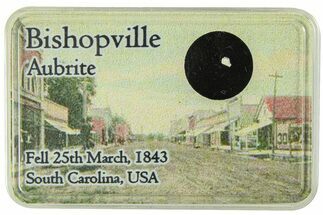This Specimen has been sold.
Aubrite Meteorite Fragments - Bishopville
This is a collection of tiny fragments from the Bishopville meteorites, an unusual kind of achondrite called an aubrite that fell near the town of the same name in South Carolina in 1843. They come in a bespoke acrylic display case.
This aubrite is the second ever witnessed fall of a meteorite of this class! On March 23, 1843, residents in and around Bishopville, South Carolina witnessed a fireball and subsequent sonic boom as the aubrite entered the atmosphere and embedded itself in about three feet of soil. A single 6-kilogram stone was recovered for the impact site. Three years later, it made its way into the collection of Charles Upham Shepard, a famed American mineralogist and meteoricist of the time.
Today, this stone is disseminated between many research institutions. It is very rare to find this meteorite available for purchase, making this out-of-this-world find all the rarer!
Today, this stone is disseminated between many research institutions. It is very rare to find this meteorite available for purchase, making this out-of-this-world find all the rarer!
About Aubrites
Aubrites are a unique class of achondritic meteorites that represent some quite extreme formation conditions in the early solar system. Aubrites are almost all breccias consisting of whitish enstatite, with occasional inclusions of olivines, nickel-iron, and troilite, along with impact-melted clasts seen in achondrites.
Enstatite is a form of orthopyroxene that forms in igneous conditions and is considered an early stage of mineral formation in the solar system. Enstatite meteorites likely originate from E-type (enstatite-rich) asteroids close to the sun, particularly the near-Earth object 3130-Eger. It has even been observed outside of the solar system around evolved stars and planetary nebulae!
Aubrites are a unique class of achondritic meteorites that represent some quite extreme formation conditions in the early solar system. Aubrites are almost all breccias consisting of whitish enstatite, with occasional inclusions of olivines, nickel-iron, and troilite, along with impact-melted clasts seen in achondrites.
Enstatite is a form of orthopyroxene that forms in igneous conditions and is considered an early stage of mineral formation in the solar system. Enstatite meteorites likely originate from E-type (enstatite-rich) asteroids close to the sun, particularly the near-Earth object 3130-Eger. It has even been observed outside of the solar system around evolved stars and planetary nebulae!
Achondrites are a type of stony meteorite that lacks chondrules--round grains that aggregate from molten or partially molten droplets in space to form chondrites. Achondrites still contain grains, but their textures are extremely distinct and analogous with igneous processes rather than the chondrule-producing conditions at the beginning of the solar system.
Achondrites make up about 8 percent of all known meteorites. They are almost all regolith breccias, ejected from impacts on larger asteroids and sometimes the moon and Mars. Most are HED (howardite-eucrite-diogenite) in composition, sourced from the asteroid Vesta: it is the second largest asteroid in the Solar System and the only asteroid visible to the naked eye.
Achondrites make up about 8 percent of all known meteorites. They are almost all regolith breccias, ejected from impacts on larger asteroids and sometimes the moon and Mars. Most are HED (howardite-eucrite-diogenite) in composition, sourced from the asteroid Vesta: it is the second largest asteroid in the Solar System and the only asteroid visible to the naked eye.
TYPE
Enstatite Achondrite (Aubrite)
LOCATION
Bishopville, Lee County, South Carolina
SIZE
50+ Fragments
CATEGORY
SUB CATEGORY
ITEM
#285975
 Reviews
Reviews












